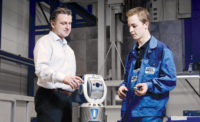Most of the molds were manufactured using computer numeric controlled (CNC) vertical machining centers. The company purchased a new horizontal machining center, but it was not yielding expected results. According to Craig Jorstad, CNC coordinator at Desenco, operators reported that it was almost impossible to attain accurate Z depths and repeatability in the Z axis. "Setting tool lengths on the machining centers was extremely difficult, and the machines did not cut required depths and had shallow or deep variances as high as 0.0025 inch," he says.
One reason for these problems was the machine center's high-speed spindle and Cat shank. When the machine is run at high speeds such as 15,000 rpm, centrifugal force opens up the spindle and the tool physically draws back into the taper, and as this occurs, the result is an unpredictable variation in depth-of-cut, says Jorstad.
As a way to solve these problems, Desenco managers decided to in-stall a Mida Laser Toolsetter supplied by Marposs Corp. (Auburn Hills, MI). The laser toolsetter allows Desenco to check parts at operational speeds.
Prior to the laser toolsetter, operators attempted to manage the problem by measuring tools in the static condition. A tool in the static condition however, may have different dimensions than a tool that is rotating, because an operator cannot manually measure a moving tool. With manual measurement comes human error and unpredictable results. If an operator forgets to substrate the dimensions of the shim that is placed between the tool and the surface, then the measurement is incorrect and the part has to be scrapped.
Using manual measurements, operators were never certain of the depths they would achieve, nor could they count on repeatable patterns, comments Jorstad. Depending on the properties of various tools, variances ranged from 0.0005 inch to -0.0025 inch. Desenco adheres to strict tolerances of + or - 0.0005 inch for most of the features cut for the molds, and the resulting step variances were unacceptable with operators attempting to make adjustments to attain required depths.
For example, accurate core pin orientation is particularly critical to successful mold production. Core pins are used to create holes in parts and during the machining, core pin height is maintained by a counterbore. "The core pin comes up from underneath the cavity and its orientation in that cavity in terms of its height is established by a counterbore on the bottom plate," explains Jorstad. "That counterbore has to be held to a very tight tolerance in terms of its depth if we are going to be able to maintain pin height. We try to hold counterbores at + or - 0.0005 inch."
The Mida Laser automatically measures rotating tools on CNC-driven machines using a noncontact laser probe. When the laser beam--which is transmitted to a high precision photo diode--is broken by a cutting tool, the sys-tem performs the necessary mea-suring operations, thus automating the tool offset operation. For tools with a minimum dimension of 0.2 millimeter, the system has a repeatability of greater than 1 micron. The laser compensates for the dynamic errors of the machine tool, spindle and tool holder, which in turn improves performance of the machine, while providing greater consistency among operators, says Jorstad.
The Mida Laser provides other benefits as well, including faster setup, Jorstad adds. During manual setup, the amount of time required for setting tools is dependent on the number of tools required for a particular application. For example, if an operator is manually setting up 10 tools, each tool would be checked and then entered into the machine control. A trial part is then cut and offsets are adjusted based on the measurements from the trial part. Typically this process requires up to 11/2 hours to complete. However, using the laser toolsetter, the same 10 tools can be set up in less than seven minutes without an operator having to manually input data into the machine control, thus, eliminating operator error.
Marposs Corp.
(248) 370-0404
www.marposs.com
